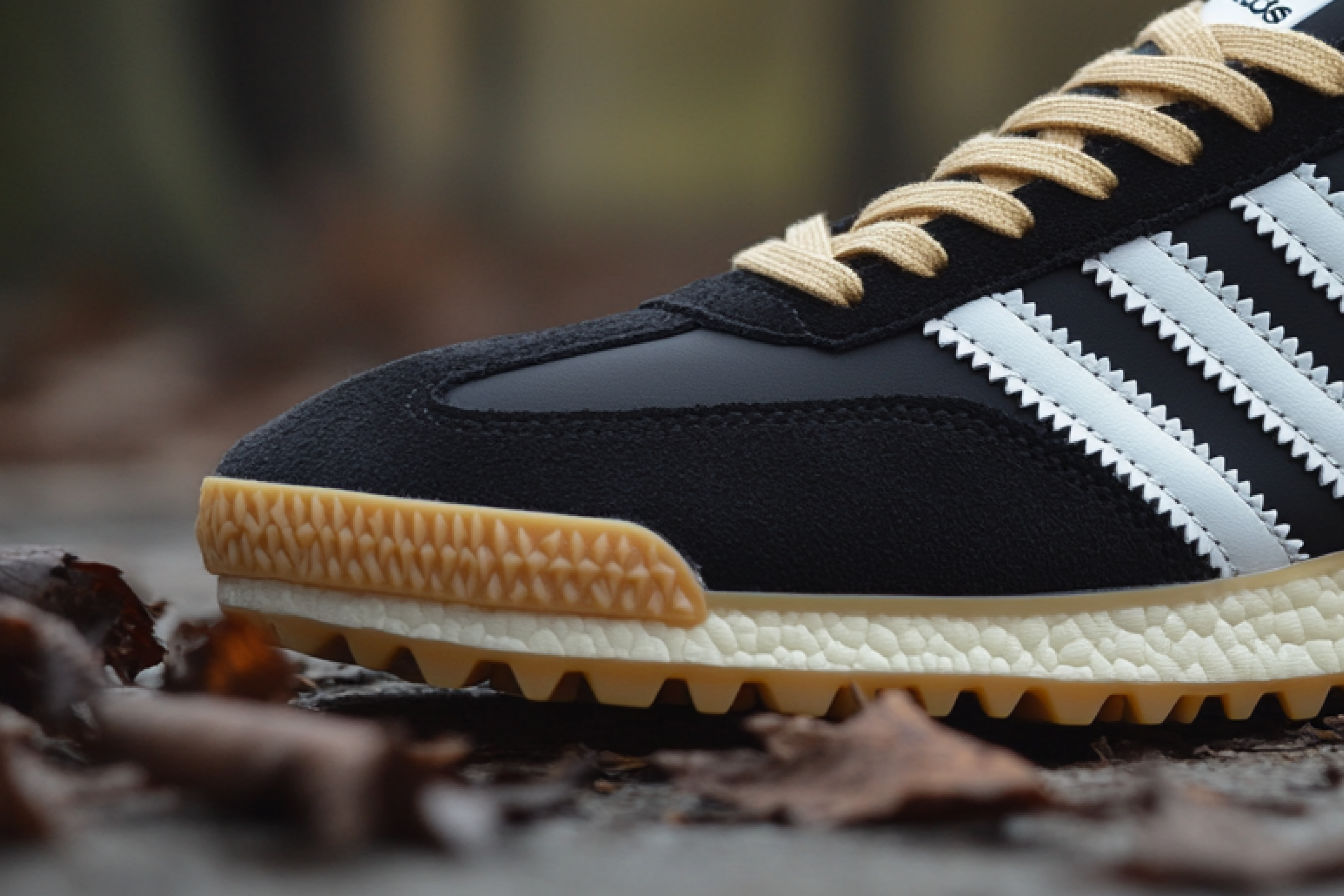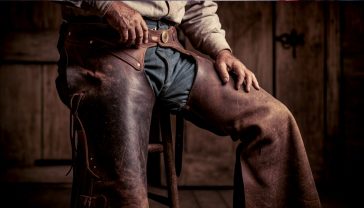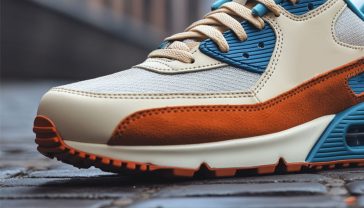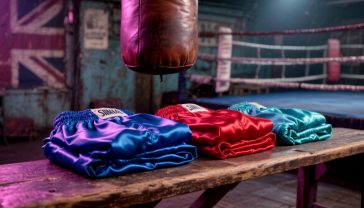The Story of the Adidas Samba: How a Frosty Football Pitch Gave Us a Timeless British Style Icon
From 1949 frozen football pitches to 80s terraces and modern fashion, this is the definitive story of how the Adidas Samba became a British style icon.

This post may contain affiliate links. If you make a purchase through these links, we may earn a commission at no additional cost to you.
Picture a Saturday afternoon in Britain. It could be anywhere, from a bustling London high street to a rainy Manchester housing estate or a quiet pub in Glasgow. Look down, and you’ll see it. A flash of three stripes on a low-profile, gum-soled shoe. You’ll spot it on the feet of a dad chasing his kid, a student heading to the library, a fashion-conscious teenager, and an old-timer reading the paper. It’s the Adidas Samba, and it’s more than just a shoe—it’s a piece of British cultural furniture.
For over 70 years, this humble trainer has done the impossible. It’s gone from being a piece of specialist sports kit to a uniform for rebellious subcultures, a Britpop stage essential, and now, a global fashion must-have. It’s a shoe that has lived a hundred different lives without ever really changing its soul. But how did a simple football trainer, designed in post-war Germany, become so deeply woven into the fabric of British style?
This is the complete story of the Adidas Samba. It’s a journey that takes us from frozen pitches and five-a-side halls to the roaring football terraces of the 1980s, the indie clubs of the 90s, and the TikTok trends of today. Grab a brew, get comfy, and let’s dive in.
From Frozen Pitches to Futsal Halls: The Birth of a Legend
To understand the Samba, you have to go back to a cold, muddy field in Germany. The year is 1949, and the world is still rebuilding after the war. A German cobbler named Adolf ‘Adi’ Dassler is busy in his workshop. His mission is simple but revolutionary: to create the best possible shoes for athletes.
A German Solution to a Wintry Problem
Back then, footballers had a massive problem during winter. When the ground froze solid, their normal studded boots were useless. Players would slip and slide all over the pitch, making the game chaotic and dangerous. Adi Dassler, being the practical genius he was, decided to solve this.
He tinkered and experimented, searching for a material that could grip icy surfaces. He found his answer in gum rubber—a sticky, durable material perfect for the job. He designed a new sole with three sections, covered in little suction cups. When a player put their weight on it, the sole would grip the frozen ground like a limpet. It was a game-changer.
To protect the player’s feet from the tough leather and the cold, he added a reinforced suede panel over the toe area. This became known as the T-toe, an iconic feature that’s still on the shoe today.
With the design sorted, it needed a name. The 1950 FIFA World Cup was being held in Brazil, a country famous for its sunshine and Samba dancing. Dassler, a clever marketer, decided to name his winter boot the “Samba.” It was a brilliant, slightly ironic move that connected his very German, very practical shoe to the glamour and rhythm of Brazilian football.
The Evolving Design: Built for Purpose
The first Sambas, released in 1950, looked a bit different from the ones we see today. They were taller, more like a mid-cut boot, to offer more ankle support. But as the years went on, the world of football changed.
A new, faster version of the game was becoming popular, played on hard indoor courts. It was called futsal. For this game, players needed a shoe that was light, flexible, and allowed them to feel the ball. The big, clunky boots of old just wouldn’t cut it.
Adidas realised their Samba was almost perfect for the job. They just needed to tweak it. They lowered the ankle cut, making it the sleek, low-profile shoe we now recognise. The durable leather upper could take a beating, the suede T-toe was perfect for protecting the foot during toe-pokes, and that amazing gum sole gave players incredible grip on polished wooden floors. The Adidas Samba, as we know it, was born. For decades, it was simply the best indoor football shoe you could buy. End of story. Or so it seemed.
The Boot That Jumped the Fence: How the Samba Conquered British Terraces
For years, the Samba was a purely functional piece of kit. You wore it to play five-a-side, and that was it. But in the late 1970s and early 1980s, something strange started to happen in Britain. The Samba began to disappear from the sports halls and reappear in a very different arena: the football terraces.
A New Uniform for the Terraces
This was the era of the “casuals.” It was a new subculture born on the terraces of clubs in cities like Liverpool, Manchester, and London. These were lads who were obsessed with two things: football and fashion. They followed their teams across the UK and into Europe for competitions. And while they were abroad, they discovered a world of sportswear brands that you just couldn’t get back home.
They’d come back from a trip to Germany or France with rare Adidas trainers, Sergio Tacchini tracksuits, and Fila jackets. It was all about one-upmanship—having the gear that no one else had. It was a way of looking smart and showing you were in the know, without wearing your team’s colours, which often attracted trouble from the police or rival fans.
The Samba, with its sleek European look, was perfect. It was understated, stylish, and, at the time, not widely available in the UK. Owning a pair was a badge of honour. It said you were part of this new, fashion-conscious tribe.
More Than Just a Shoe: A Mark of Identity
For the casuals, the right trainers were everything. They were the foundation of “the look.” You’d see lads dressed head-to-toe in designer gear—Lois or Farah jeans, a Lacoste polo shirt, a Pringle jumper—and finished off with a pristine pair of Sambas, Gazelles, or Forest Hills.
The Samba wasn’t just footwear; it was a status symbol. It showed you had taste, that you’d travelled, and that you were part of a movement. It was the quiet nod that replaced the loud roar of club scarves and rosettes. The shoe had officially jumped the fence from the pitch to the stands, and in doing so, it became a cornerstone of British youth style.
From the Stands to the Stage: The Samba’s Second Wave
The influence of the casuals trickled down through the 80s and into the 90s, where the Samba found a new set of fans. This time, they weren’t in the stands; they were on the stage.
Britpop’s Favourite Footwear
The 1990s saw the explosion of Britpop. Bands like Oasis, Blur, and The Verve dominated the charts, and their style was heavily influenced by the football and mod cultures of previous decades. It was a look rooted in working-class swagger: parkas, trackie tops, straight-leg jeans, and, of course, Adidas trainers.
The Gallagher brothers from Oasis were often seen sporting a pair of Adidas. Ewan McGregor’s character Renton famously sprints down the street in a pair of Sambas in the opening scene of the iconic 1996 film Trainspotting.
The Samba became part of the unofficial uniform for 90s indie kids. It was cheap, durable, and effortlessly cool. It had a gritty authenticity that chimed perfectly with the music and the mood of the decade. It wasn’t trying to be fancy; it was just a great, no-nonsense trainer. This cemented its place in the British style hall of fame.
A Quiet Classic
After the Britpop boom, the Samba settled into a comfortable role. Throughout the 2000s and 2010s, it wasn’t a “hype” shoe. You didn’t see people queuing around the block for it. But it never, ever went away.
It became a reliable classic, a go-to for people who valued timeless design over fast-fashion trends. It was the shoe you’d buy because you knew it looked good and would last for years. It sat quietly on the shelves of sports shops, a constant presence, waiting for its next moment in the spotlight. And that moment was just around the corner.
The Great Samba Revival: Why Everyone is Wearing Them (Again)
In the early 2020s, the Samba didn’t just come back—it exploded. Suddenly, it was everywhere. On Instagram influencers, on Hollywood A-listers, and on the feet of seemingly every young person in every major city. So, what happened? It was a perfect storm of social media, celebrity culture, and a thirst for simpler times.
The Perfect Storm: TikTok, Tastemakers, and Timelessness
First came the celebrity effect. Style icons who are watched by millions, like models Bella Hadid and Hailey Bieber, or musicians like A$AP Rocky and Frank Ocean, started wearing Sambas. They paired them with everything from baggy jeans to smart trousers, showing how versatile the shoe could be. The photos went viral, and a new generation was introduced to the classic trainer.
Then came TikTok and its “aesthetics.” Suddenly, trends weren’t just about single items but entire looks or moods. The biggest of these was “Blokecore,” a style directly inspired by 90s British football fans. Think vintage football shirts, straight-leg jeans, and a pair of Adidas Sambas. The Samba wasn’t just part of the look; it was the essential piece that held it all together. Other trends, like the relaxed “Tometo Girl” aesthetic, also adopted the Samba for its effortless, retro feel.
Finally, there was a feeling of trainer fatigue. For years, the market had been dominated by chunky, futuristic “dad shoes.” They were big, bold, and often very complicated. The Samba was the complete opposite. Its design is simple, sleek, and has barely changed in 70 years. In a world of crazy designs and loud colours, the Samba felt authentic, grounded, and refreshingly simple.
The Collaboration Game-Changer: Wales Bonner and Beyond
The final ingredient in the Samba’s revival was a touch of high-fashion magic. In 2020, Adidas teamed up with the British designer Grace Wales Bonner. Her collaboration took the humble Samba and elevated it into a luxury object.
She kept the classic shape but added exquisite details like a fold-over tongue, crochet-style three stripes, and satin linings. These versions sold out instantly and were soon reselling for hundreds of pounds. The Wales Bonner Sambas showed the world that this old-school football shoe could be a piece of high-fashion art.
This was followed by other popular collaborations with brands like Kith and Palace, each one adding a new twist to the classic design and keeping the hype train rolling. The Samba was no longer just a classic; it was the hottest shoe on the planet.
Owning a Piece of History: The Modern Samba Guide
So, you’re thinking of getting a pair? Good choice. But with so many versions out there, it’s worth knowing the basics.
Samba OG vs. Classic: What’s the Difference?
You’ll mainly see two versions in the shops: the Samba OG and the Samba Classic. They look very similar, but there are a few key differences.
- The Samba OG: This is the one most fashion fans go for. The “OG” stands for “original,” and its design is more faithful to the vintage models. It has a shorter tongue with the blue Adidas logo, a soft leather upper, and a classic suede T-toe. It’s the cleaner, more stylish of the two.
- The Samba Classic: This version leans more towards its indoor football roots. It has a much longer, padded tongue that was originally designed to be folded over to cover the laces. The sole is also slightly different, designed for durability on sports courts.
For everyday style, the Samba OG is almost always the one to go for.
How to Style Adidas Sambas in 2025: A British Perspective
The beauty of the Samba is its versatility. It really does go with almost anything.
- The Casual Classic: This is the easiest way to wear them. Pair black or white Sambas with some good quality denim (straight-leg or relaxed fit works best) and a simple jumper, t-shirt, or jacket. It’s a timeless, foolproof look.
- The ‘Blokecore’ Nod: Embrace the trend by pairing your Sambas with some track pants or baggy trousers and a vintage-style football shirt or track jacket. It’s a comfortable, casual look with a cool, retro edge.
- The Smarter Take: Don’t be afraid to dress them up. Sambas look surprisingly good with smarter trousers or chinos. For women, they’ve become a go-to for pairing with wide-leg trousers, skirts, and even dresses, creating a brilliant “high-low” mix of smart and casual.
Keeping Your Kicks Clean: A Simple Guide
To keep your Sambas looking fresh, a little care goes a long way.
- For the leather: Use a soft brush to get rid of any loose dirt. Then, mix a little bit of mild soap with warm water and use a cloth to gently wipe down the leather. Don’t soak it.
- For the suede T-toe: Suede is tricky. Never use water on it. The best tool is a dedicated suede brush or a simple pencil eraser to gently rub out any marks or scuffs.
- Laces: Take the laces out and either wash them by hand with soap and water or pop them in a laundry bag and put them in the washing machine.
Why the Samba Will Never Die: An Enduring Legacy
From a frozen football pitch in Germany to the cutting edge of global fashion, the Adidas Samba has had a truly incredible journey. Few products, let alone a simple trainer, have stayed relevant for so long and connected with so many cultures.
It’s a story of perfect, functional design meeting cultural moments at just the right time. It was adopted by the casuals because it was different. It was worn by Britpop bands because it was authentic. And it’s been revived today because it’s a timeless classic in a world obsessed with fleeting trends.
The Samba is a chameleon. It can be a sports shoe, a subculture uniform, or a high-fashion statement, all without changing its core identity. It’s a testament to the idea that truly great design doesn’t need to shout. It just needs to be good at its job, and the rest will follow.
So, the next time you see that flash of three stripes and a gum sole on a British street, you’ll know it’s not just a shoe. It’s a piece of history. A quiet icon that has walked through decades of British life and, you suspect, will be walking through many more to come.






